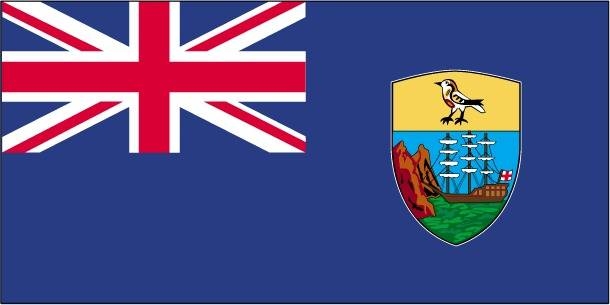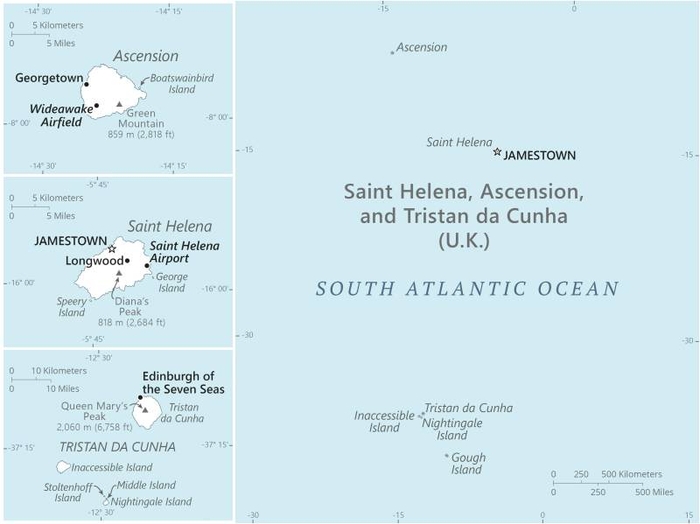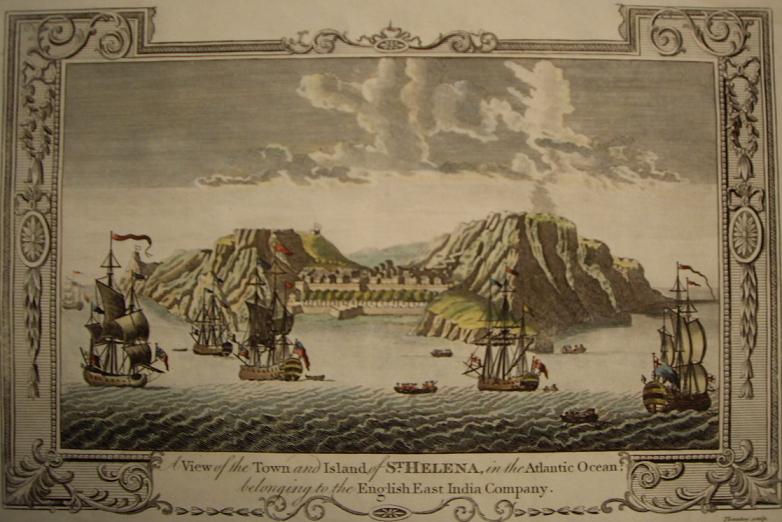124 Saint Helena (UK)

Blue with the flag of the UK in the upper hoist-side quadrant and the Saint Helenian shield centered on the outer half of the flag. The upper third of the shield depicts a white plover (wire bird) on a yellow field. The remainder of the shield depicts a rocky coastline on the left, offshore is a three-masted sailing ship with sails furled but flying an English flag.
Flag courtesy of the CIA World Factbook

Map courtesy of the CIA World Factbook

A View of the Town and Island of Saint Helena in the Atlantic Ocean belonging to the British East India Company, engraving, c. 1790
Last updated on March 20, 2025
Government
According to Britannica, as outlined in the constitution of St. Helena, Ascension and Tristan da Cunha (2009), the executive authority of the territory is vested in the British monarch, represented by a governor appointed by the monarch. St. Helena, Tristan da Cunha, and Ascension share the same governor, attorney general, Supreme Court, and Court of Appeal but have separate legislatures. The governor presides over and is advised by the Executive Council, which comprises three ex officio members—the chief secretary, the financial secretary, and the attorney general—and five members of the Legislative Council, who are elected to serve on the Executive Council for two-year terms. The legislature of St. Helena consists of the British monarch (nominally) and the Legislative Council, which has a speaker, a deputy speaker, the same three ex officio members who serve on the Executive Council, and 12 members who are elected to four-year terms (though the governor can dissolve the legislature before the end of the full term, at which time new elections are held).
The territory’s residents are British subjects. Legislation passed in Britain in 1981 established that they were not full citizens of the United Kingdom, as had been traditionally held. This greatly limited the population’s opportunities for employment abroad, and the territory’s constitutional relationship with Britain continued to come under periodic review and amendment. The British Overseas Territories Act (2002) granted British citizenship to the people of the overseas territories, including those of St. Helena, Tristan da Cunha, and Ascension.
Air Safety Support International (ASSI)
All aviation and air access matters on the Island are the responsibility of the St Helena Government (SHG) Civil Aviation (CAA) function within the Treasury, Infrastructure & Sustainable Development Portfolio. The regulation of aviation safety and security in St Helena is delegated to Air Safety Support International (ASSI). Those regulatory functions that are retained by the Governor are managed on a day-to-day basis by the Civil Aviation function – The Civil Aviation function is the lead in SHG in relation to all aviation regulatory matters. A critical function is also leading on strategic planning to support ongoing air access in support of Island needs – including supporting economic and tourism development and aero-medevac capability.
Airspace
SkyVector – Google Maps – ADS-B Exchange
ICAO countries publish an Aeronautical Information Publication (AIP). This document is divided into three parts: General (GEN), En Route (ENR) and Aerodromes (AD). ENR 1.4 details the types of airspace classes they chose to adopt from classes A through G.
Drone Regulations
ASSI – Legal requirements for the operation of small unmanned aircraft in the UK Overseas Territories
Advanced Air Mobility (AAM) Regulations & Policies
None found by the author.
However, should you, the reader, happen to stumble across something to the contrary, please email the author at FISHE5CA@erau.edu and you may be mentioned in the ACKNOWLEDGEMENTS section of this book by way of thanks for contributing to this free eBook!
Advanced Air Mobility (AAM) News
None found by the author.
However, should you, the reader, happen to stumble across something to the contrary, please email the author at FISHE5CA@erau.edu and you may be mentioned in the ACKNOWLEDGEMENTS section of this book by way of thanks for contributing to this free eBook!
Short Essay Questions
Scenario-Based Question
You have been hired by a Drone Startup Company. Your boss has immediately assigned this job to you.
They need you to prepare a one-page memo detailing the legalities of using a drone to film in Saint Helena.
They need you to mention any national laws and local ordinances.
They specifically want to know what airspace (insert pictures) you will be operating in and whether or not you need an airspace authorization.
Does it matter whether or not you are a citizen of the country?
Lastly, there is a bonus for you if, as you scroll through this chapter, you find any typos or broken links!
Short Essay Questions
- What are the drone categories?
- How is registration addressed?
- How is remote ID addressed?
- What are the model aircraft rules?
- What are the commercial drone rules?
- Are there waivers or exemptions to the rules? If so, for what?
- Would you share a link to an interactive airspace map?
- How is BVLOS addressed?
- How can you fly drones at night?
- How can you fly drones over people?
- Where do you find drone NOTAMs?
- What are the rules for drone maintenance?
- What are the rules for an SMS program?
- What are some unique rules not mentioned above?
- What are the C-UAS rules?
- What are the AAM rules?

